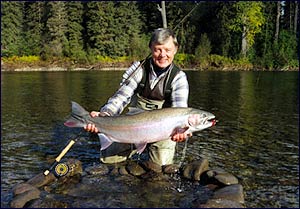back to MUSEUM

World Record (IGFA) Freshwater Fly Caught Rainbow (Steelhead) Trout on 20-pound tippet. (2000-2003)
This superb wild torpedo demonstrates the success of MāHUNT-like strategies. Two fishing lodges are located on the banks of the Sustut River. Access to fishing the Sustut is quite limited since (except for a lumber/pulp railroad crossing upriver) a helicopter or airplane flight from Smithers, B.C. about one hour away is required. The two fishing lodges have combined with fishing organizations to:
1) allow logging in the valley only in areas not visible from the river’s bank and farther away from any tributaries, rivlets, or the main river than required by law, thereby reducing silting which hampers or destroys steelhead spawning beds and preserving the wild experience on the river;
2) delay until 2003 the building of an additional railroad bridge across the river, which could also hasten silting, reduce the wild pristine aura of the river, and add additional pressure on the river. In 2003 one new bridge was installed across one of the narrowest and highest walled points of the river with miniscule aesthetic and habitat destruction.
This large buck Steelhead (notice the reddish color on the gill cover and sides) was live-released by James A. Schneider on a barbless “Schneider Swirl” (created by James A. Schneider) on a 20 pound tippet with a single handed nine (9) weight Sage fly rod on September 23, 1999 at 9:35 AM after thirteen (13) minutes in Lookout on the Sustut River in British Columbia. Its length was 37 1/2” with a girth of 19 3/4.” It officially weighed 19 pounds and 4 ounces and was the new World Record IGFA Freshwater Fly Caught Rainbow (Steelhead) Trout on a twenty (20) pound tippet from 2000 through 2003.
In addition, since the posting of this new IGFA World Record (which highlighted the pinnacle—perhaps unique—nature of the Sustut River) environmental (non-fishing) organizations have added their pressure to preserve the Sustut from further logging and bridge construction. Steelhead are very sensitive to pressure. Any increase in fishing, boating, and floating activities on the Sustut would dramatically reduce the experience on the river and potentially diminish or curtail the propagation of the wild steelhead that migrate there to spawn and later return to the sea without dying like pacific salmon. Wildlife must pay to stay.
The aspect of insight and creativity (like MāHUNT’s strategy) is also shown in the effectiveness of the “Schneider Swirl” (visible in the Steelhead’s lower jaw). New ideas building on past success must be tried to preserve (near) pristine wildness and the magnificent creatures that draw humankind to visit those areas with minimal disturbance and therefore become invested in preserving them and their essence.